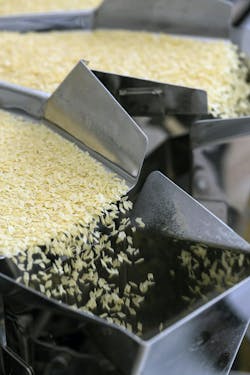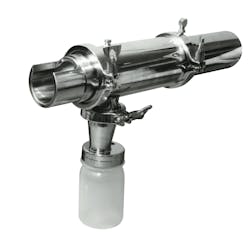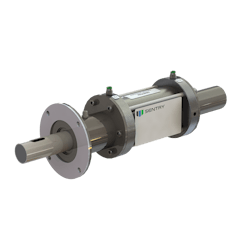In the world of food testing, the analytical techniques to measure threats are precise, often down to the sub-parts-per-trillion level. Yet, food testing commonly starts with an unreliable sample captured using a rudimentary spigot or scoop sampling method that leaves the door open for dangerous contamination and product recalls.
Representative sampling is the act of capturing a limited volume of material that accurately reflects the characteristics of the entire lot, batch, or process stream, and it is critical to ensuring product quality and safety. A representative sampling that is reliable and repeatable — from validation of raw ingredients to quality testing at each key processing stage — is the only way to ensure confidence in food testing results.
Types of samplers
Every bulk solids production environment is different, and setting up a successful representative sampling system requires a deep understanding of the sample’s characteristics and the application.
Homogeneous operations, such as flour milling, and heterogeneous operations, such as pet food and co-packaging, need to meet different analytical and compliance requirements, so it is only natural that certain samplers are best suited for certain applications. The process stream, space conditions, material characteristics, safety hazards, certification standards and regulatory requirements all play a role in defining your sampling application.
The sampler type is usually determined by the particle homogeneity and where the sampling point is located within a process. There are three primary types of samplers that are used for a variety of bulk solids applications: point samplers, strip samplers and cross-cut samplers.
Point samplers. A point sampler takes a sample from a specific point in a process stream. This sampler type works best with homogeneous flour or grain without variation in particle size, density or composition.
Strip samplers. Strip samplers obtain samples from a narrow portion across the entire width of the product flow and are typically used in gravity chutes or pneumatic transfer lines. A strip sampler works best in an environment where the product is not homogeneous and has a wide range of particle sizes.
Cross-cut samplers. A cross-cut sampler collects a sample across the entire width of a process stream, producing the most representative sample. This type of sampler mounts in gravity chutes and vertical or angled spouts.
Automated sampling
While sampling has traditionally been performed manually, the future of bulk solids sampling is automated. Automated sampling provides the increased accuracy and repeatability, limiting bias and allowing precise samples to be taken at regular intervals.
Automated sampling obtains samples in a process line, chute, hopper, bin, conveyor or tube without the need for direct human interaction. This allows production to run continuously while protecting operators, ensuring the integrity of the sample and increasing sample efficiency. Additionally, incorporating an electronic sampler controller into previously existing equipment and systems allows the sampling process to run without any operator engagement at all.
Within a process, automated sampling presents a number of advantages, from increased product quality to increased profitability.
First, the technology available allows automated sampling methods to increase lot-to-lot repeatability, meaning there is little variation from one lot to the next. With such careful monitoring technology available, quality control testing using representative sampling is the foundation for consistent quality, taste and texture.
Automated sampling has a similar effect on operator safety. Often, manual sampling requires an operator to reach into a live process, greatly increasing the risk of injury as well as possible contamination. By eliminating operator intervention, automated sampling systems keep operators and processes safer.
Implementing an automatic sampling system also increases process efficiency in several ways. First, automatic sampling eliminates downtime since operators do not waste time manually obtaining potentially contaminated, inaccurate samples. Automatic sampling can also help to identify whether upstream equipment and/or processes are functioning properly; by catching quality or safety incidents early in the process, plant managers can pinpoint detection at the original source. As a result, representative samples obtained automatically provide an immediate return on investment since preventing just one food recall allows the automated sampling solution to pay for itself many times over.
Lastly, automated sampling methods reduce process waste. By sampling the food product during production, the waste from using packaged final products as samples is totally eliminated.
Types of automatic samplers
Automatic samplers are available in three basic sampling modes and three common operating types. Sampling mode refers to how the sampler collects the sample, and it is determined by the process location, access and application.
Sampling modes
The three sampling modes in automatic sampling follow the exact same logic as the sampler types already discussed. An automatic point sampler (Figure 1) enters the material stream and takes a sample only at the point where it stops. An automatic strip sampler (Figure 2) enters the material stream and samples a portion of the stream all the way across the stream. An automatic cross-cut sampler (Figure 3) takes a sample from the stream’s entire cross-section by moving back and forth across the stream.
Operating types
The operating type describes the automatic sampler’s material-collecting mechanics. In all three operating types, a motor or pneumatic device activates the sampler to enter and withdraw from the material stream. The material flows into the sampler and then is released either by mechanics or gravity into a sample container that is manually or automatically removed to an analysis device or quality control personnel.
- The tube or tube probe sampler is the simplest and most common of the three operating types. A tube sampler is essentially a tube with an aperture near one end that is inserted into the material stream and collects material that flows into the aperture. The tube is then retracted from the material stream.
- The tube-and-auger sampler type is also a tube with an aperture in it, but an auger within the tube helps move the flowing material into the sampler.
- The automatic cross-cut sampler, also referred to as a pelican sampler, has an opening at the top that passes collected material through a discharge port and into a sample collection container.
Things to consider before installing an automatic sampling system
While an automatic sampling system is an excellent solution, there are a variety of factors to consider before purchasing and installing the system to guarantee a streamlined installation process.
Process location and space restrictions are major, yet often overlooked, factors to consider when installing any sampling system, but especially an automated system. For example, while a tube-and-auger sampler can be mounted horizontally, a tube sampler is typically mounted at a 45-degree angle. If space is at a premium and either sampler will work for the application, it is best to go with the tube-and-auger sampler.
When it comes to choosing a specific model, a range of samplers is available in all of the basic sampling modes and operating types in varying configurations. Regardless, it is critical to consider:
- Available utilities for powering the sampler;
- Equipment the sampler will be interfaced with;
- The specific point in the process (packaging, mixing, etc.); and
- The sampler’s control method.
There are an overwhelming number of threats to food quality and safety, and the key to ensuring quality control and a reliable food safety program is testing samples that are representative of the entire product batch. While automated sampling systems provide a number of advantages, it is crucial to consult with professionals to determine the best sampling solution available that is capable of meeting your needs while keeping safety at a premium.
Tod Myers ([email protected]; 262-354-6337) is the product manager of bulk solids at Sentry Equipment, a global manufacturer of representative sampling and analysis solutions. Myers has more than two decades of experience in the bulk solids industry working directly with customers to determine the best systems for their particular needs.
Sentry Equipment
www.sentry-equip.com





